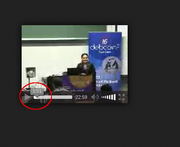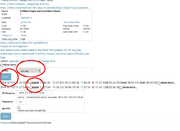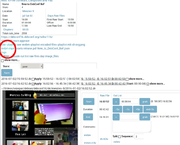DebConf16/Videoteam/Veyepar
We use veyepar to review and transcode talks. Veyepar was used at Debconf14 and Debconf15 too.
Contents |
[edit] First review
If you want to help, do the following (if you're going to do it remotely, skip the first two steps and go directly to the veyepar interface):
- Find a network cable. Reviewing DV files over wireless is no fun.
- Mount storage1.dc16.debconf.org:/home/veyepar/Videos/veyepar/debian/debconf16/dv on a local directory somewhere.
- Be sure to be on a wired network. This won't work over wifi
- storage type is nfs. You'll need the nfs-client package
-
mount storage1.dc16.debconf.org:/home/veyepar/Videos/veyepar/debian/debconf16/dv /mntshould do the trick
- Go to the veyepar interface for debconf16. At the top of the page, log in as user reviewer, password reviewdc15.
- Coordinate on the #debconf-video channel which talk you're going to review. Talks to review are in "edit" state (#1).
- The files are in dv/<room>/<date>/<start hour>.dv (or .ts for menzies 12). Veyepar will make an educated guess as to which files belong to which talk. Play the files it suggests in a media player, and confirm that they contain the complete talk. Next, do one or more of the following, as appropriate:
- If veyepar included a file that shouldn't be part of this talk, deselect the "Apply:" checkmark for the relevant file.
- If veyepar missed some files, enter the filename of the missed file (including the last directory, the one containing the date) in the "Rf filename:" form at the bottom, enable the "get this:" checkbox below that, and hit the bottom "Save" button on the webform. The form will refresh, and the missing file should now be added.
- If some of the recorded files contain large amounts of noninteresting information (e.g., the recording starts with 10 minutes of people walking into the room, people walking out of the room, the speaker testing his microphone, etc), click on the "Show more..." check box of the relevant file. In the "cut list" web form, enter the start and/or end times of the interesting content. Tip: the > button moves the playhead to the time in the box. the "grab" button copies the time the playhead is at and puts it in the box. Note that the "Grab" button gives you timestamps in seconds, not in the hh:mm:ss format, but that is ok. Use whichever you prefer.
- Note: the times to enter here (in HH:mm:ss format) are the times from the beginning of that particular file, as they are shown by a media player ; not the wall clock time or the time from the end (for end clock) or time from start of usable recording or whatnot.
- If you enter a time, make sure that you do not forget to enter the hours too. Otherwise it gets interpreted as hh:mm rather than mm:ss, and your timestamps are very much off.
- If veyepar's educated guess is correct or you are happy with the changes you've made, simply ensure (all) the relevant file(s) have the "Apply:" checkbox enabled, ensure that the "state" is set to "encode", and hit the topmost "Save" button on the webform.
- Move on to the next talk.
Note, it is not possible to do something wrong. Transcoding a video does not destroy the original files, so it is always possible to clear the form and start over. Feel free to experiment!
[edit] Issues
There are some notes about talks with issues on http://piratepad.net/znYC5q3zTw
If these issues are also in the dv files, there isn't much that can be done, and the files can be released that way. Otherwise, ask on #debconf-video
[edit] Final review
Don't forget to coordinate on IRC!
Once talks have been encoded and published (in "post" state), we need to review them again to make sure everything is fine. You don't need to watch the whole video: bits here and there is fine (specifically, but not only, beginning and ending).
For final review, see veyepar's "webm" link (go to the talk page, look for "webm" above the "state" drop-down menu)
If you do not have a webm compliant browser, you can use the /webm folder to see the final files, as you did for first review with /dv folder to see the recorded files.
Once you have seen the video, several possibilities:
- you are sure the video is OK, simply put the videos to the "make public" state (#9) in veyepar.
- if you notice the first reviewer cut off too much (and whatever is lost can be found in the .dv files), edit the list of changes and set it to "encode" again.
- if it is unusable, set it to "borked" and talk to wouter
Don't forget to coordinate on IRC!
[edit] Hints on veyepar states for DebConf 2016
| value | name | (m)anually/(a)utomatically set | meaning (roughly deducted, feel free to specify) |
|---|---|---|---|
| 0 | borked | m (or auto when scripts error) | Something went wrong, special care must be taken, indicate it in comments. Do not use without telling wouter. |
| 1 | edit | a | A First review must be done on these files. See above. |
| 2 | encode | m | Files have been reviewed once, they will be transcoded. See above. |
| 3 | push to queue | a | Transcoded files have been built |
| 4 | post | a | Transcoded files have been uploaded to veyepar.debian.org, final review needs to be done. |
| 5 | richard | N/A | Not used |
| 6 | review 1 | N/A | Not used |
| 7 | N/A | Not used | |
| 8 | review 2 | N/A | Not used |
| 9 | make public | m | Final review has been done, files will be published now. |
| 10 | tweet | N/A | Not used (might appear for a short time between upload and "we're done") |
| 11 | to-miror | N/A | Not used (might appear for a short time between upload and "we're done") |
| 12 | done | a | Files have been published. Note: it takes a while for files in this state to appear on meetings-archive.debian.net, since there is one more sync step to be done that veyepar has no influence over. |
An asterisk (*) beside the value means that the file is locked, usually by a process doing the encoding
[edit] FAQ
[edit] Audio
Question: (first review) The audio level of the speaker mic and the "audience" mic in this video are quite different (altought not catastrophically so): Should I do something? Write a comment?
Answer: There's probably not much that can be done about that. Can you understand both the speaker and the audience? And is this the preview or the final version? If it's the preview, add a note in veyepar and set it to encode: once the final version is there, we can check, but we'll probably have no choice but to release it like that The audio levels are adjusted during the encoding, but that will probably not fix this issue
Question: (final review) There is some static in part of the talk, I guess that's just the way it was recorded? Should I mark as "Make Public"?
Answer: No: ask someone in #debconf-video to look at it: if the dv files have the same problem, sometimes the static is in the master files, in which case there is nothing we can do except accept the noise and publish; however if they do not have the same problem, then something went wrong with transcoding and we should fix that first
Question: (first review) The audio is quite low: what should I do?
Answer: Just try to make sure that the whole of the talk is at about the same level if it's "loud" in the beginning but much less later on, that might be a problem. If it's at the same level, the encoding will fix it.
[edit] Cutting
Question: Is it worth it cutting 20 seconds?
Answer: It may be. There's no extra effort to do that, so don't feel like it might be a problem
Question: I'm doing the final review of a talk and I realized that it wasn't cut correctly at the end. What should i do?
Answer: You can change the status back to "edit" or, even better, correct the edits and set it to "encode" again
[edit] Misc
Question: In veyepar, there are several files with the same name, all with different length. Whats that? Which should one select and insert times?
Answer: In vocto, you get 30 min long files. When the operator hits "cut" in voctomix, veyepar will show the file twice. Basically that means the second file is "the bit after the cut", and the first file is "the bit before the cut". It will already have the "start" and/or "end" times set for that file, so you just need to choose the bit that seems most relevant for that particular talk. Of course, the operator might have messed up and the cut could be on the wrong place, in which case you need to fix it up anyway As for which pseudo file use to adding cutting times: either will work they both refer to the same real file. They're both there so that you can more easily select one if you don't want to change the cuts, but they're both exactly the same file.Just make sure you select only one of the two. If you select both, the talk will start to repeat itself
Question: There are many files for just one talk, how should i choose?
Answer: You'll want to select all files that are part of the recording,and, if necessar,y set a start time for the first file as well as an end time for the last file. Do not enter end time in between files: the second and third etc files are going to be appended to the first one, and then you get a jump.
Question: I'm doing the first review: should i watch all the files in their entirety or can i skim through them in order to just see the cutting times?
Answer: It's ok to skim
Question: I marked a whole bunch of "make public", but they're back in the "done" state, and it didn't seem to have done anything with them.
Answer: "done" means they're pushed to the meeting-archive server (apu) but it will take few hours for them to be visible
Still in doubt? Ask your question on #debconf-video (irc.oftc.net).



